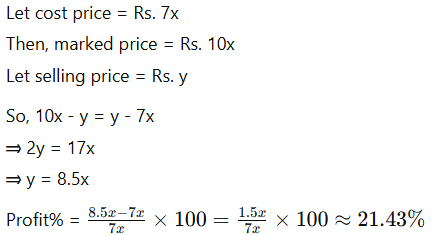Question
The marked price of an item is to its cost price as 10
is to 7. If the profit earned equals the discount allowed, what is the approximate profit percentage?Solution
ATQ,

HCF of two numbers 70 and 140 can be expressed in the form of (20m – 110) whereas LCM of these two numbers can be expressed in the form of (40n – 20...
Rs. 21,000 is split between 'P', 'Q', and 'R' such that one-third of P’s share equals 25% of Q’s share, and equals one-seventh of R’s share. Find ...
The smallest number which when divided by 28 and 32 leaves remainder 10 and 14 respectively is:
The LCM of two numbers is 40 times its HCF. If the product of the numbers is 1440, find their HCF.
Two positive integers multiply to 5070, with their highest common factor being 13 and their sum amounting to 143. What is the difference between these t...
Find the smallest 3-digit number that leaves 2 as remainder when divided by 6, 4 and 7.
Three numbers are in the ratio 5:3:2 respectively. If the HCF of the numbers is 4, then find the LCM of the numbers.
Can you determine how many factors the number 1,560 has?
If the highest common factor of two numbers is 12, then which of the following may be the least common multiple of the numbers?
Train X running at a speed of 32 km/hr crosses train Y in 20 seconds. Find the speed of train Y (in km/hr), if the sum of the length of train X and Y is...
Relevant for Exams:



